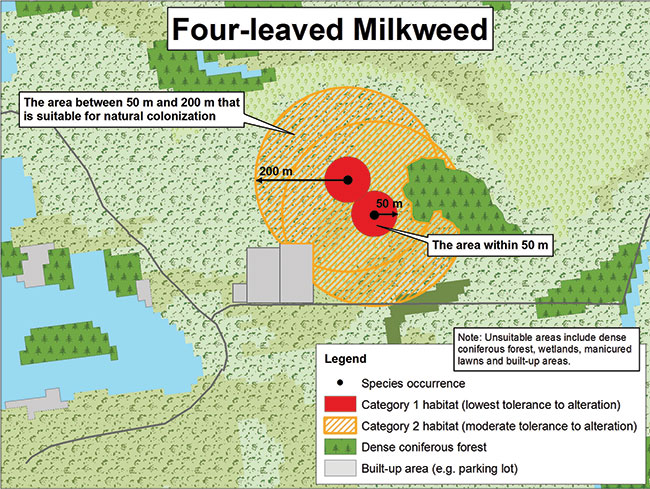Four-leaved Milkweed Habitat Protection Summary
This document provides a brief description of the area that is protected as habitat for the Four-leaved Milkweed through a habitat regulation under the Endangered Species Act.
Four-leaved Milkweed is a perennial herb of woodlands and forest edges that grows up to 80 centimetres in height. In Ontario, populations of Four-leaved Milkweed have been recorded from only two localities: the Bay of Quinte region along the north shore of Lake Ontario and the Niagara River Gorge area. The species was assessed by the Committee on the Status of Species at Risk in Ontario (COSSARO) and listed as endangered on September 28, 2010 due to its extremely low abundance and habitat decline. More information about the species' status can be found at: Four-leaved Milkweed webpage.
The habitat regulation for Four-leaved Milkweed protects an area within 50 metres of a Four-leaved Milkweed, as well as areas suitable for natural colonization between 50 and 200 metres from a Four-leaved Milkweed. These areas are protected until six consecutive years of documented non-use. Areas suitable for natural colonization include treed alvars, woodlands, cultural meadows, young forest, thickets, and other similar areas. Areas that are not suitable for natural colonization include wetlands, dense coniferous forests, manicured lawns, areas of permanent open water, and paved roads.
The regulation applies where the species occurs in Prince Edward County, the city of Belleville and the township of Tyendinaga in the County of Hastings, the township of Greater Napanee within the County of Lennox and Addington, and the townships of Niagara Falls and Niagara-on-the-Lake in the Regional Municipality of Niagara. As of December 2012, this species has only been confirmed recently from Prince Edward County.
Supporting rationale
- The area within 50 metres of a Four-leaved Milkweed is intended to protect the area immediately adjacent to the plant and to maintain essential microhabitat conditions.
- The area between 50 and 200 metres of a Four-leaved Milkweed is intended to protect the portion of that area that is suitable for natural colonization by Four-leaved Milkweed and to ensure connectivity within local populations.
- The six-year term allows for sufficient time to determine that the site is no longer being used.
Activities in Four-leaved Milkweed habitat
Activities in regulated habitat can continue as long as the function of these areas is maintained and individuals of the species are not killed, harmed, or harassed.
Generally compatible:
- Use of existing, sanctioned recreational hiking or bicycle trails.
- Continuation of most existing trail maintenance practices, such as pruning of shrubs or trees, or removal of an individual shrub or tree.
- Removal of invasive plant species in accordance with best management practices.
Generally not compatible footnote * :
- Construction of houses, other structures or roads.
- Creation of new trails.
- Use of all-terrain vehicles.
- Significant alteration or clearing of native vegetation.
Key terms
- Treed Alvar: An area of thin soil over flat limestone or marble rock with 25% to 60% tree cover. It is characterized by distinctive plants and animals and is maintained by landscape processes, such as severe drought and periodic flooding.
Below you will find an example diagram of how this regulation would be applied to protect habitat for this species. It indicates how the protected habitat has been categorized, based on how the species uses the habitat and how much activity or change can occur within the habitat, as per the policy "Categorizing and Protecting Habitat Under the Endangered Species Act". This policy can be found at: Categorizing and Protecting Habitat Under the Endangered Species Act.
Sample application of the Habitat Regulation:
Map 1: Sample application of the Habitat Regulation

Enlarge Map 1: Sample application of the Habitat Regulation
The content of this summary is provided for convenience only. For accurate reference and the most recent version of the regulation, please view Ontario Regulation 832/21 on e-Laws.
Footnotes
- footnote[*] Back to paragraph If you are considering an activity that may not be compatible with regulated habitat, please contact your local MNR office for more information and/or to discuss ESA authorization options.